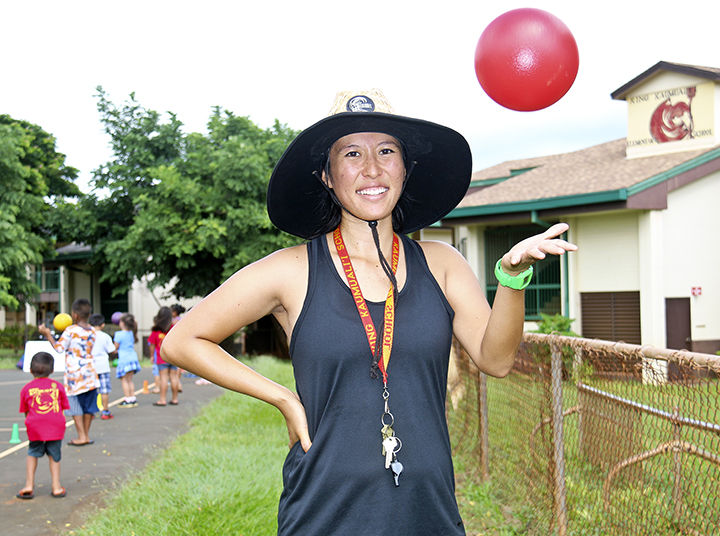Two Kauai Area Complex public schools have been recognized with “Excellence in Wellness” Awards, while another received the second lowest mark in the state, according to findings from the second Safety and Wellness Survey. King Kaumualii Elementary and Waimea Canyon
Two Kauai Area Complex public schools have been recognized with “Excellence in Wellness” Awards, while another received the second lowest mark in the state, according to findings from the second Safety and Wellness Survey.
King Kaumualii Elementary and Waimea Canyon Middle are among 55 Hawaii public schools to receive awards for achieving 90 percent or higher on the survey during the 2012-13 school year. King K tallied the island’s highest percentage at 95.2, while WCMS came in second with a 90.9.
Physical Education Teacher Carie Inouye said there is a team effort at King K to promote wellness and physical activity, from providing healthy, nutritious snacks and ensuring students get ample time to play, to its bi-monthly “Walk to School Day.”
“It feels good to be recognized,” Inouye said, adding that an award banner now hangs in the cafeteria.
The focus on wellness, she said, is having a trickle-down effect, with students getting excited about walking to school and trying new, healthy foods.
At the opposite end of the rankings is Kapaa Elementary, which scored 38.1 percent, the lowest on the island and second only in the state to Pahoa High and Intermediate School on the Big Island at 36.4 percent.
In an email, Kauai Complex Superintendent William Arakaki said he was proud of Kauai’s results and that all schools are “working diligently in meeting the standards of the Wellness Guidelines to create change for healthy living and wellness within what we do at the school, family settings and community.”
He declined to comment on Kapaa Elementary’s low score.
Wellness guidelines
The SAWS is an online survey administered annually by the Hawaii State Departments of Health and Education to principals at all public, non-charter schools to monitor compliance with a number of separate DOE wellness guidelines and evaluate school health and safety programs, according to a release.
The guidelines are a set of standards for foods and beverages provided to students that include goals for school-based wellness committees, health and physical education, and other practices that support student health.
All 255 Hawaii public schools have been required to meet the Wellness Guidelines since 2011.
“Healthy and physically active students are more likely to be academically motivated, alert and successful,” Health Director Dr. Linda Rosen said in a release. “Schools that follow the Wellness Guidelines provide a healthy foundation for their students to thrive in school and life.”
While King K fully met all but one of the possible 21 guidelines for elementary schools, Kapaa Elementary met only eight.
Other Kauai schools and their scores are as follows: Chiefess Kamakahelei Middle (72.7); Eleele Elementary (71.4); Elsie H. Wilcox Elementary (76.2); Hanalei Elementary (76.2); Kalaheo Elementary (81); Kapaa High (81.8); Kapaa Middle (59.1); Kilauea Elementary (85.7); Koloa Elementary (61.9); Waimea Elementary (66.7); and Waimea High (72.7).
School progress
Jennifer Ryan, the DOH school health coordinator, said Kauai has its success stories, but that every school is unique with its own set of challenges. And with no penalties in place, a major challenge for her department has been finding an incentive to get schools to make progress.
Statewide, 241 schools — 95 percent — completed the survey, meeting an average of 76 percent of the DOE guidelines.
Kekaha Elementary and Niihau High and Elementary were among those schools that did not participate.
Highlights of the survey results show that during the 2012-13 school year, 94 percent of Hawaii schools (including all Kauai schools except Kapaa Elementary) reported integrating nutrition education into multiple areas of the curriculum such as math, science and English language arts.
Additionally, 95 percent (including all but Waimea Elementary on Kauai) report they have required physical education classes that are aligned with state standards, according to a release.
Additionally, 100 percent of schools report promoting the importance of eating nutritious meals and snacks, while 77 percent have a wellness committee that oversees the implementation of the Wellness Guidelines.
Ryan said those committees have proven essential.
“Often times not having the wellness committee, unfortunately, makes it challenging for the schools to achieve wellness,” she said. “That’s kind of the cornerstone.”
All but three Kauai schools have an established wellness committee. Those that don’t — Kapaa Elementary, Kapaa Middle and Waimea Elementary — accounted for three of the island’s four lowest scores.
Principals reported that the greatest challenge for Hawaii schools is ensuring that only nutritious foods and beverages are sold or provided to students outside the cafeteria, with only 39 percent of schools meeting this requirement in 2012-13, the release states.
On Kauai, five schools — Eleele Elementary, Kapaa High, King K, Koloa Elementary and Waimea Canyon Middle — met the above requirement.
Arakaki said ongoing efforts to promote nutrition and health education, physical activity and physical education will impact Kauai students in living healthy lifestyles to be ready to learn and successful in school and in life.
“Together we can!” he wrote, “in attaining our vision that all Kauai students are educated, healthy and joyful lifelong learners who contribute positively to our community and global society.”
SAWS data for 2013-14 school year is currently being collected. The Safety and Wellness Survey Data Report for School Year 2012-13 is available at www.hawaiipublicschools.org.
•••
Chris D’Angelo, environment writer, can be reached at 245-0441 or cdangelo@thegardenisland.com.


